As a certified dog groomer, you might choose to do more with your talents than work for a grooming company or pet store.
In fact, you might want to start a dog grooming business of your own!
Starting a dog grooming business comes with the challenges that any business faces, but the initial setup can be the most confusing.
After that, you can tailor your company to your needs and create the life and business you’ve always dreamed of.
This guide breaks down the process of starting a dog grooming business, step by step, to get you on the way to becoming a successful business owner.
The Easy Parts of Starting a Dog Grooming Business
If you plan to start a dog grooming business, you’re likely already an excellent dog groomer—and that’s half the battle! You already know what you’re doing and how to make dog parents happy. And when you make dog owners happy, it’s easy to get referrals from your loyal customers to gain new business.
You should find that getting your business off the ground isn’t too challenging if you’re in a non-competitive area, as there’s always a need for a qualified dog groomer wherever there are dogs around.
Additionally, most states do not currently require a dog groomer to have professional training and licensing for them to run their business. Although certification and licensing can help set you apart, not having them usually won’t stop you from becoming a business-owning dog groomer, which can cut down on the time it takes you to get started. It’s more important to have experience as a dog groomer that gives you the skills you need to produce happy clients.
When it comes to managing your business, software like Gingr can make things much easier. The pet business software takes care of appointment booking, payment processing, pet report cards, and other aspects of a dog grooming business that take time away from your services. Groomers can take advantage of Gingr’s features for as low as $80 per month.
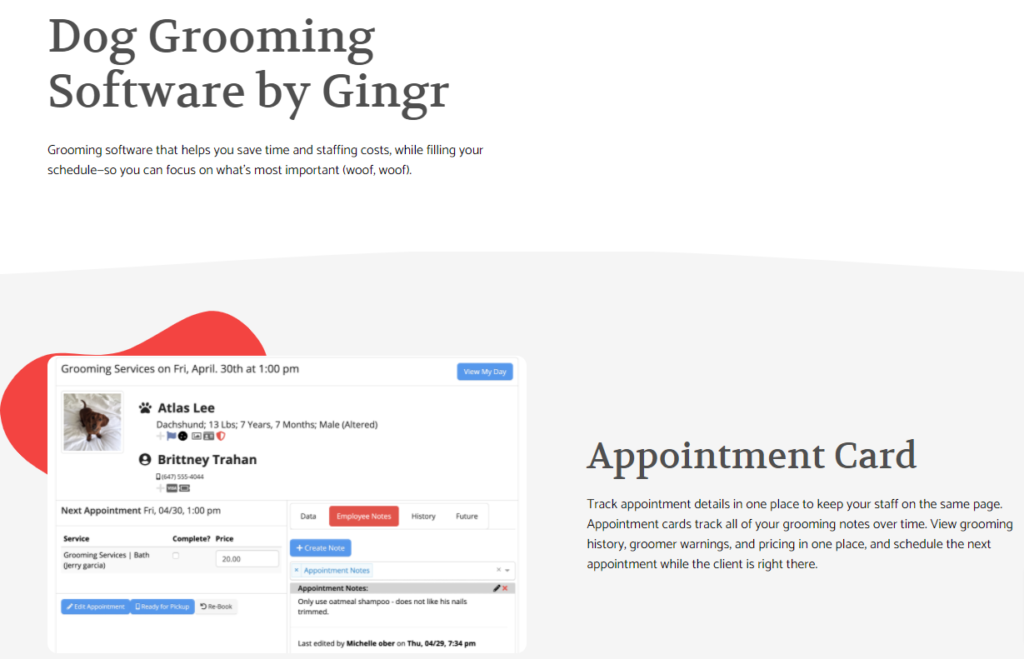
The Difficult Parts of Starting a Dog Grooming Business
Dog groomers can start small and grow their businesses as they gain new clients. Still, even small businesses aren’t all smooth sailing. You might face a few obstacles along the way, and understanding what they are now can help you prepare for them during the process.
As I mentioned, dog groomers don’t always need to have professional licenses. However, they do need business licenses through their state and, possibly, their locality. Business licenses come with additional fees and paperwork that you’ll need to have in place before beginning business operations.
Another challenge is the extensive startup costs that can go into this business. Dog groomers use a lot of equipment that can quickly add up, like bathtubs, grooming tables, crates, and possibly even a dedicated vehicle. Without a financial nest egg to get off the ground, you might find yourself in significant debt as you get moving.
Additionally, groomers need insurance to protect their business and their clients, and plans can be costly. However, liability insurance is non-negotiable, as it covers your business if a dog gets injured or lost while in your care. It can also protect your business if a customer or employee gets bitten or injured by an aggressive or anxious dog. Add to that property insurance to cover damage from dogs, nature, or accidents, and the expenses add up fast.
It’s in your best interest to check with your state about the required insurance for your business. An insurance agent can help you with this. But, consider going over bare minimums if you can afford it. Your plan should offer ample protection for your customers and business.
Finally, you might have difficulty finding trustworthy and skilled employees for your team. Not everyone can be a groomer, and not all excellent groomers have people skills that cater to your customer service needs. It’s a delicate balance to find the right people to fit your team.
You might try recruiting software to save time posting jobs and screening applicants. You can start with Recooty for free for one open job slot and posting to multiple job boards, scaling up to the $49/month plan as you grow.
Step 1: Plan Your Business
Planning is, quite possibly, the most important step you’ll take when launching a business, as it sets the tone for everything your business does now and in the future. Here’s what you need to do before getting those adorable pups through your door.
Get Certified
Getting a license or certification isn’t always required for dog groomers to start taking clients. However, it certainly doesn’t hurt, especially from a business standpoint. Think about it: Would you rather your dog visit someone who completed a grooming certification program or a person with no credentials to their name who says they can groom dogs?
The first option is who you’d probably pick. Your customers will also prefer their dog’s groomer to be able to prove their expertise, and certification can help. Certification is especially crucial if you plan to specialize in specific services, like grooming for dog shows, or breeds, like curly-haired dogs.
The National Dog Groomers Association of America (NDGAA) sets the standard in this area with workshops and a certification program that’s recognized across the country. Members can also benefit from professional liability insurance, discount programs, and tax and legal assistance.
Identify Your Clients
What type of clients are you interested in bringing on board?
Some groomers are open to grooming all kinds of dogs, while others prefer to specialize in small breeds, large breeds, or show dogs. Mobile pet groomers cater to owners who cannot leave their homes or work varied schedules outside of traditional business hours. Dog salons tend to be for high-end clients willing to pay big bucks to have their pooch pampered.
Figure out your niche now so you can more easily target your ideal clients once you’re ready to open.
Nail Down Services and Pricing
Generally, dog groomers offer bathing, flea and tick removal, nail trims, and haircuts. Some groomers add more off-beat services that dog owners look for, like de-matting, hair styling, teeth brushing, and winter coat stripping.
First, consider what you know how to do best. Start with those services that show off your skills and keep customers happy. You can always expand what you offer later as you learn more or add new team members and have a larger client base with a need for those services.
Once you determine your services, start to explore pricing. Check competing dog groomers in and around your service area to understand what going rates are. Remember to consider your target clients; those looking for monthly trims aren’t going to be willing to pay the same rates as customers interested in high-end, spa-quality grooming.
Find a Location
Dog groomers have several location options to consider, each of which can play a role in their monthly expenses and how many clients they can handle at a time.
While mobile grooming vans are affordable, easy to get started with, and convenient for customers, they usually can only hold 2-3 dogs at a time. Other affordable but potentially size-restrictive options include running your business in a salon rental space or from your home.
Renting space in a shopping or strip mall could offer more room but will also be costlier. The priciest option is buying your own space, but it can also provide long-term security and a bit more control over how you run your business.
Speak with a realtor in your area that specializes in commercial properties to help you in your search.
Step 2: Set Up Business Software
From scheduling appointments to accepting payments, a lot more goes into a dog grooming business than simply grooming dogs. Business software specifically designed for pet-focused businesses can streamline all the extra tasks on your plate to give you more time to make money doing what you do best.
Sign Up for Gingr
Gingr is a full-service software for pet businesses, like dog groomers. Groomers can use the software to set their schedules, allow online customer booking, and accept payments, including tips. Dog parents can even receive a pet report card detailing everything you did for their pup during their stay.
Gingr takes care of the business side of things, too. Manage your employees’ schedules, track inventory with Gingr’s retail management features, and take advantage of automated pricing that keeps invoicing simple.
Choose the Right Plan
Dog groomers can choose from three Gingr plans starting at $80/month when paid annually. For most groomers, the lowest-tier plan, Pet Spa/Train, should do the trick. It features an online portal, automated email and SMS reminders for customers, card payments, an employee time clock, and appointment scheduling.
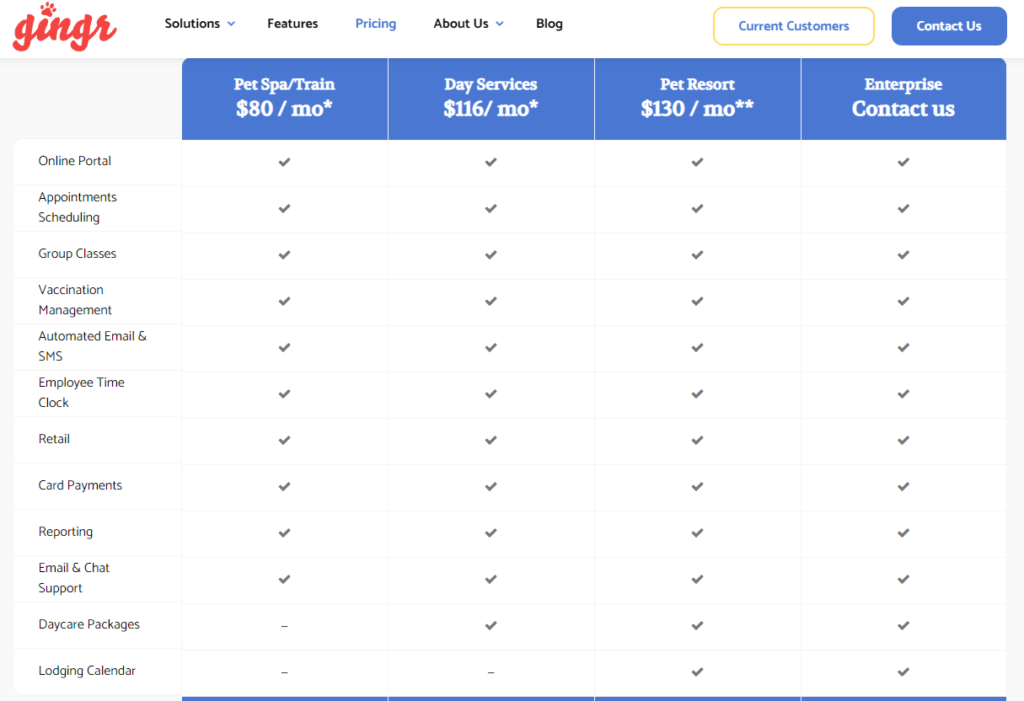
The only time you’d need to opt for a different plan is if you plan to offer dog daycare or boarding services in addition to your grooming services. These plans add prepaid daycare packages for customers to book and a lodging calendar to view your clients’ reservations at a glance.
Step 3: Legally Set Up Your Business
Your grooming business now has a plan in place to welcome furry clients. But before you do, there are a few legalities to get situated.
Choose a Business Structure
A business structure details how a business will operate. Some entities are straightforward to set up, while others require more paperwork and planning. Your options as a dog groomer include:
- Sole proprietorship: This is the simplest business setup. As a sole proprietor, you can file your business and personal taxes together using tax form Schedule C, and you won’t need to file your business with the state. However, you’ll also be personally responsible for any business debts you incur, and it can be challenging to get loans or credit lines for your business.
- Partnership: This is similar to a sole proprietorship but with another partner who shares the business responsibilities. You and your partner will both be responsible for any business debts and taxes.
- Limited liability company (LLC): LLCs must file their business with the state. However, the process in most states is simple and affordable. An LLC separates business from personal liability, meaning that if your company gets sued or incurs debts, you won’t personally be held responsible for any monetary connection. LLCs can still file their taxes with their personal tax return.
- Corporation: There are two types of corporations: S corporation and C corporation. Corporation business owners do not get held personally responsible for business debts, but these business structures are more complicated to set up. With a C corporation, you’ll typically qualify for more tax deductions. However, they can be costly to set up, and business owners must file business taxes separately from personal. An S corporation allows Schedule C filing, making it a potentially simpler entity than a C corporation for dog groomers.
It’s important to check with an experienced business attorney before choosing your business entity. They can guide you on the best option for your business, along with ensuring that you meet any local regulations.
Get Accounting in Order
Keeping personal and business finances separate is ideal when tax time rolls around. Your grooming business should have a separate business bank account for accepting payments and purchasing things for your business. BlueVine is excellent for brand-new small businesses, as it has no monthly fees and no minimum deposits.
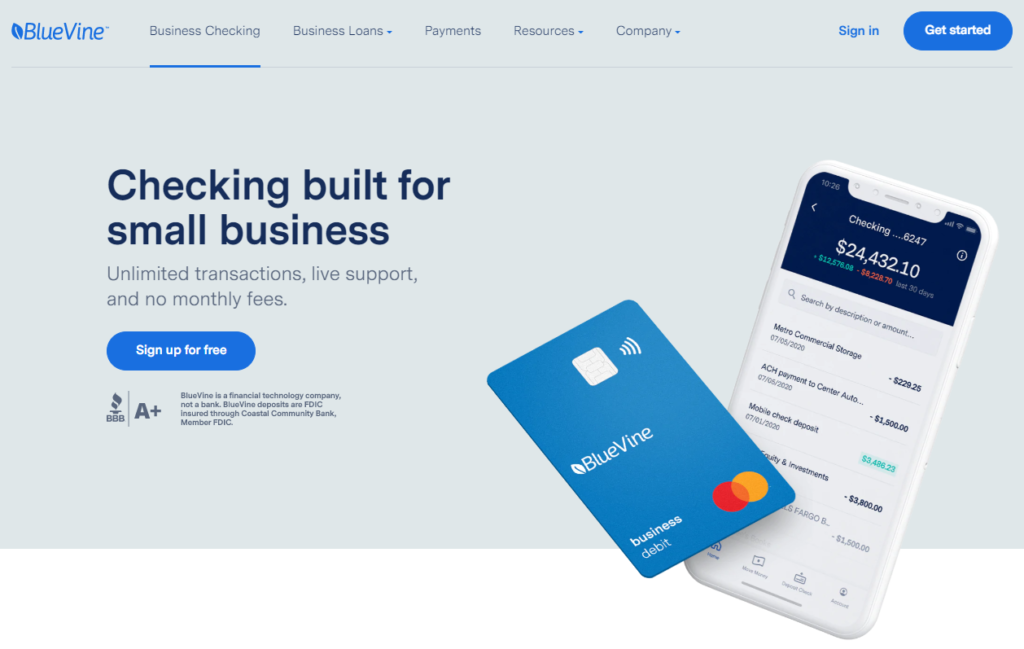
Speaking of tax time, consider hiring an accountant as soon as possible. An accountant experienced in business taxes can help you navigate tax breaks, sales tax, and other necessary financial aspects of running a business.
Get Pet Groomer Insurance
Insurance is more of a necessity than an option for pet groomers. Most states will require you to have, at minimum, liability insurance for your business. This covers most accidents that can occur at your business, such as a dog biting you or a customer slipping on the floor.
If you plan to have employees, you’ll also need workers’ compensation, which protects employees that suffer from an injury or illness at work. Property insurance is also important to consider, as it covers weather events, theft, and other uncommon occurrences that could affect your business location long-term.
Step 4: Set Up Shop
With a legal business now ready to go, you can transition to setting up your grooming spot with all the essentials.
Purchase Grooming Tools and Equipment
Getting your grooming business off the ground is more important than packing it full of everything you might not need right away. Instead, start small. Depending on your location size, you might start with just two grooming tables and one bathtub, for example. You can always scale later; right now, it’s about having the essentials to begin bringing in customers.
As a dog groomer, the following tools and equipment are just some of what you might need to get started:
- Shop-cleaning supplies
- Bathtubs
- Grooming tables
- Dog crates
- Shears, clippers, brushes, and combs
- Shampoo and conditioner
- Scented sprays
- Towels
- Fur dryers
- Nail clippers
- Gloves
- Dog treats
- Bandanas and bows
- Ear and teeth cleaning products
- Table and chairs for the break room
- Seating for the waiting area
- Pricing board
Set Up a Phone System
Having a phone at your location is essential for customer communication. Many groomers call customers when their furry friends are ready to get picked up. And, even if you have business software like Gingr in place for booking, many customers will still prefer to call for booking or changing appointments or to ask questions about your pricing or services.
Ooma Office is one of the most affordable phone systems for small businesses, but other office phone systems might also be good options for you.
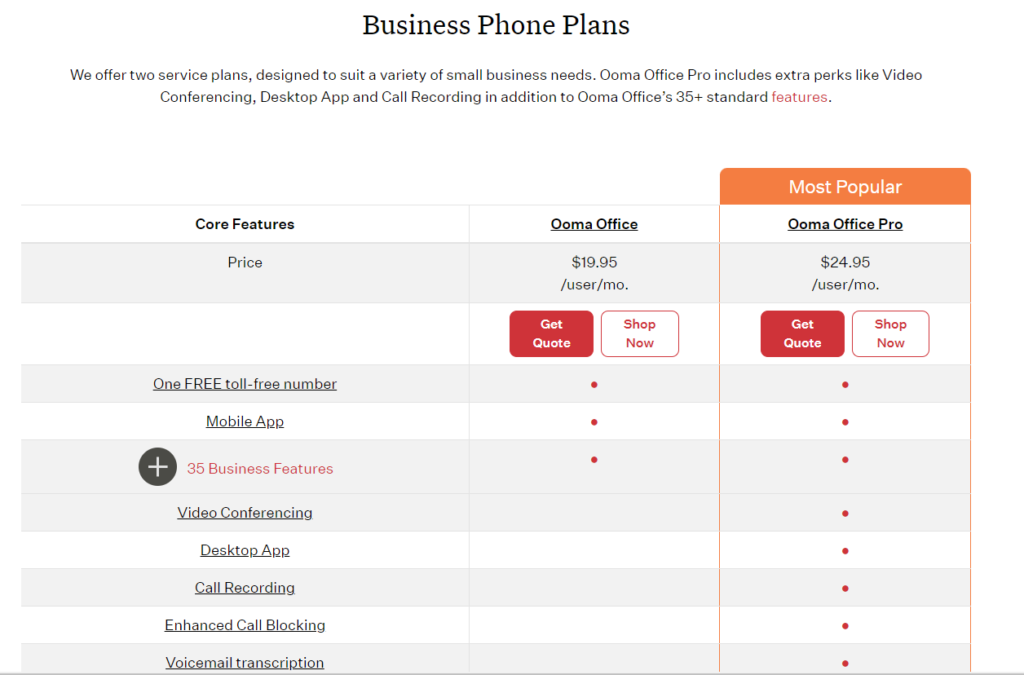
Consider Payment Types
Although accepting cash is the easiest way to take payments, it’s probably not the best long-term solution for your business. Some customers will prefer to make credit and debit card payments for services or even pay through an app. Gingr can make your payment processing easier with contactless payments, automatic subscriptions, and more.
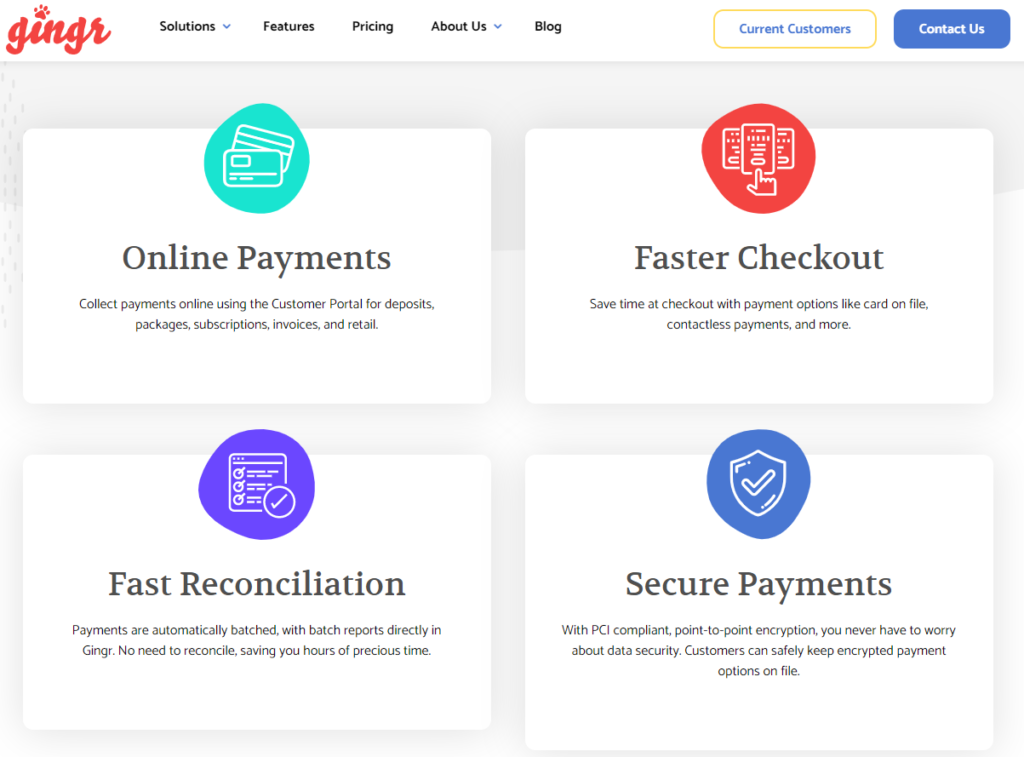
Every payment your customers make through the Gingr system will be recorded right in their accounts for their convenience, too. Payment processing is available on any Gingr plan.
Step 5: Market Your Business
To start getting customers through the door, you’ll need to market your business and continue promoting it to scale your grooming company.
Promote Your Business Locally
For your initial influx of customers, it might be best to start local. Tap into local advertising sources, like radio, newspaper, or mail adverts. You can also set yourself up with social media accounts, like Facebook and YouTube, for people in your area to learn more about you and share your posts with their friends.
Also, add your grooming business to local directories. Google My Business is one of the best, allowing people searching for a groomer in your area to find you easily. You can also try Foursquare, Yahoo! Local, and Yelp.
Finally, consider partnering with other local companies for cross-promotions. For instance, you might ask your local vet clinic if you can offer each other’s business cards to customers. Or, leave flyers that give the clinic’s dog owners a 10% discount on their first appointment at your shop.
Launch a Website
Make a presence for your grooming business online with a website. It doesn’t need to be complicated, but it should provide your basic information, like contact and pricing details.
Adding a blog to your website can also drive traffic to your business page through search engine optimization (SEO). WordPress, Squarespace, and Wix are among the best website builders for people without website design experience who want to get their site and blog up and running quickly.

Get Repeat Customers
Making the customer experience as simple as possible is one of the best ways to ensure that they return to you. Using Gingr can help you do that with simple booking, service subscriptions, and automated notifications and reminders.
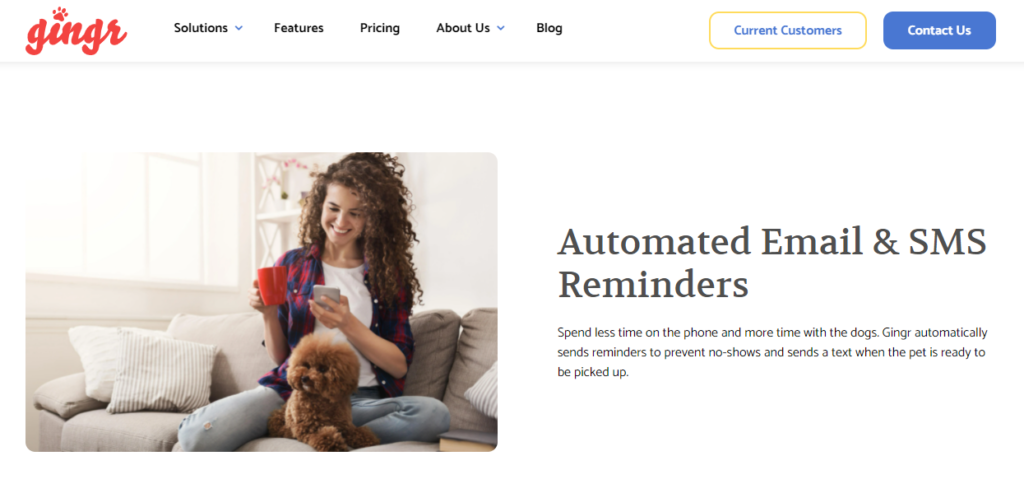
Leverage your current customer base by asking for referrals, too. When a customer sends someone new your way, you can offer special pricing on their first appointment or a free service, like nail trims, to encourage them to come. For your current customer, provide an enticing incentive, like 25% off their next appointment, to thank them for their referral.


